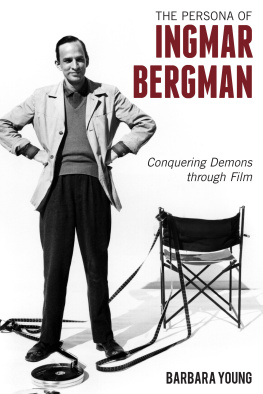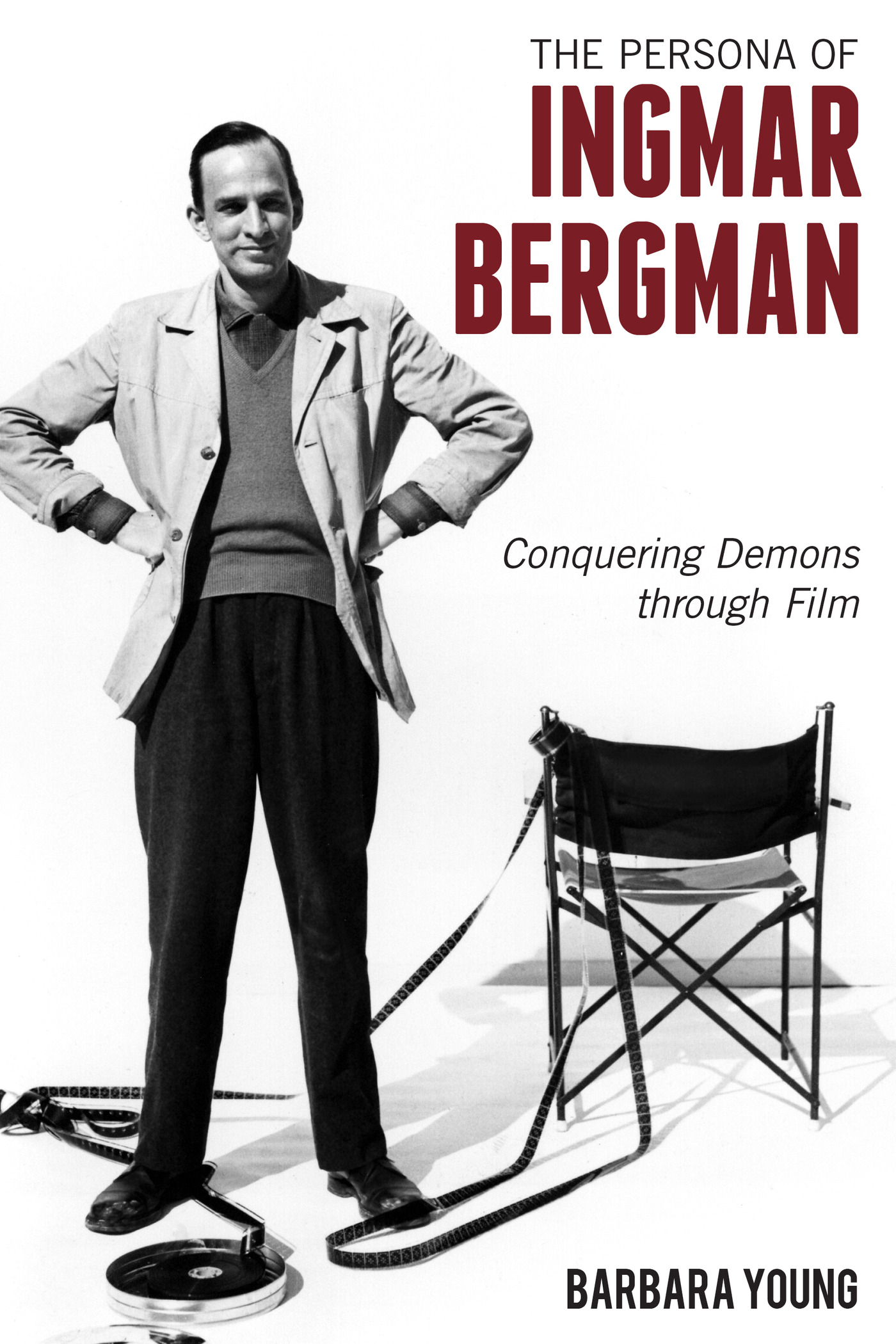The Persona of
Ingmar Bergman
The Persona of
Ingmar Bergman
Conquering Demons through Film
Barbara Young
ROWMAN & LITTLEFIELD
Lanham Boulder New York London
Published by Rowman & Littlefield
A wholly owned subsidiary of The Rowman & Littlefield Publishing Group, Inc.
4501 Forbes Boulevard, Suite 200, Lanham, Maryland 20706
www.rowman.com
Unit A, Whitacre Mews, 26-34 Stannary Street, London SE11 4AB
Copyright 2015 by Rowman & Littlefield
All rights reserved. No part of this book may be reproduced in any form or by any electronic or mechanical means, including information storage and retrieval systems, without written permission from the publisher, except by a reviewer who may quote passages in a review.
British Library Cataloguing in Publication Information Available
Library of Congress Cataloging-in-Publication Data
Young, Barbara, 1920.
The persona of Ingmar Bergman : conquering demons through film / Barbara Young.
pages cm
Includes bibliographical references and index.
ISBN 978-1-4422-4565-5 (hardcover : alk. paper) ISBN 978-1-4422-4566-2 (ebook)
1. Bergman, Ingmar, 19182007Psychology. 2. Motion picture producers and directorsSwedenBiography. 3. Bergman, Ingmar, 19182007Criticism and interpretation. I. Title.
PN1998.3.B47Y68 2015
791.430233092dc23 [B]
2015013360
 TM The paper used in this publication meets the minimum requirements of American National Standard for Information Sciences Permanence of Paper for Printed Library Materials, ANSI/NISO Z39.48-1992.
TM The paper used in this publication meets the minimum requirements of American National Standard for Information Sciences Permanence of Paper for Printed Library Materials, ANSI/NISO Z39.48-1992.
Printed in the United States of America
Dedicated to the memory of
Blanche DeBra and Harvey Young, my parents;
Dr. Lewis Hill and Dr. Sarah Tower, my psychoanalysts;
Dr. John C. Whitehorn, my professor of psychiatry at Johns Hopkins; and to my patients and Ingmar Bergman, who have taught me so much about the infinite intricacies of the mind, body, and soul.
This is what the demons that have tormented me all my life have been about: my terror that I would disintegrate and lose control of my murderous or suicidal feelings.
Bergman
From an early age, Bergman re-created in himself a kind of alternative mothergiving himself, in his fantasy
obsessed playhis own form of undivided attention.
John Lahr
Preface
We all have demons inside us that have accompanied us since childhood, and we had to find ways of dealing with them early in life in order to survive. We locked them in a closet or hid them behind walls so we werent anxious and frightened all the time, but the demons still found ways of tormenting us. We would wake with nightmares, knowing the demons were hiding under our beds. We would forget in the middle of a speech. We stopped studying so we would fail a course. As lonely as we were, we pushed people away who wanted to be friends. These painful defense mechanisms against the mysterious demons or ghosts consumed a great deal of energy and limited our ability to use the skills we possessed to live a full life.
As a psychiatrist and psychoanalyst, my job has been to help people identify who their demons really are and how and why they came into existence, and to find ways of proceeding in the face of the demons threats, recognizing that what might have killed them as a child was not going to kill them as an adult. They werent going to release the deadly monster within themselves. Therapy is a slow process, however. The demons are ferocious and tenacious. My patients had to use all the good fairy-ghosts they had been given by those who loved them, and the skills they had inherited, to lock the demons back in the closet for good. When the demons occasionally did sneak out, my patients had learned how to call them by name and gently talk them back into the past where they belong.
The majority of people have been fortunate enough in their childhood family lives to have the means to deal with their demons without realizing what theyre doing. But there are those unfortunate ones whose demons are so violent that they escape into psychosis because their damaged lives are totally unbearable, as we will see played out in Ingmar Bergmans Through a Glass Darkly and The Hour of the Wolf. When my patients were finally able to face their demons, their aggressive energy was released to be used in positive and creative ways. And if tragedy hit and the demons temporarily emerged, my patients had learned to stay with the disturbing feelings until they understood what in the present had released the ghosts from the past.
You are about to encounter a most extraordinary man, Ingmar Bergman, the Swedish filmmaker. He is extraordinary not because he is considered the finest film director in the past one hundred years, not because he was a genius in creating films of both beauty and deep understanding of the human condition, and not because he communicated directly to his audience his concern for the state of the world. (At the time he produced his early film Prison, which grew out of his own struggles to get free from the demons who imprisoned him, he remarked, I dont want to produce a work of art that the public can sit and suck in aesthetically.... I want to give them a blow in the small of the back, to scorch their indifference, to startle them out of their complacency.) What makes Bergman unique is that he conquered his demonsthe legacy of a traumatic childhoodthrough his creativity. As a youngster he had a puppet theater, he made short films with a primitive film projector, and he had an imaginative mind that could float above the many traumas he endured. And as an adultdrawing on his life experiencehe gradually managed to put his demons back in the closet for good. With no help from a psychiatristthrough intuition aloneBergman gradually faced down his demons, overcoming his terror of disintegration and death, gaining control of his murderous rage, and solving the problem of his intolerance of intimacy, which had led to his abandonment of four wives, eight children, and many mistresses.
Why did I spend four years of my life getting acquainted with this man? When I first saw The Seventh Seal I had just begun my second profession of photography. Burned into my mind to this day are three powerful images: a knight playing chess with death in the sunlight, the knight confessing to a priest (who is actually death in disguise) behind a grated window, and a young teenage girl who has been declared a witch waiting to be burned to death. As much as I was stunned in admiration of his art, I knew when I left the theater that death was real and unavoidable. Bergman had certainly delivered his blow effectively.
I didnt return to Bergman until years later when I prepared a discussion of WildStrawberries for the Baltimore-Washington Psychoanalytic Film Forum. Writing shortly after The Seventh Seal, in Wild Strawberries Bergman is again dealing with approaching death, but in a gentler way. The old doctor realizes he has lived only half a life, but while he is driving to his university to receive an award, the experiences he has in his interactions with young people along the way soften his heart. The delicate, complex artistry of the film with its many flashbacks is unsurpassed. Bergman said it was his fathers loneliness he was writing about. Later he realized the loneliness was his own.
It was at this point that my engagement with Bergman began. I watched his films in sequence. Contained in the DVDs were interviews with him, discussions of his works, and a few films of him at work on the movie set. Many books written by Bergman scholars are available. Shortly after the film
Next page











 TM The paper used in this publication meets the minimum requirements of American National Standard for Information Sciences Permanence of Paper for Printed Library Materials, ANSI/NISO Z39.48-1992.
TM The paper used in this publication meets the minimum requirements of American National Standard for Information Sciences Permanence of Paper for Printed Library Materials, ANSI/NISO Z39.48-1992.